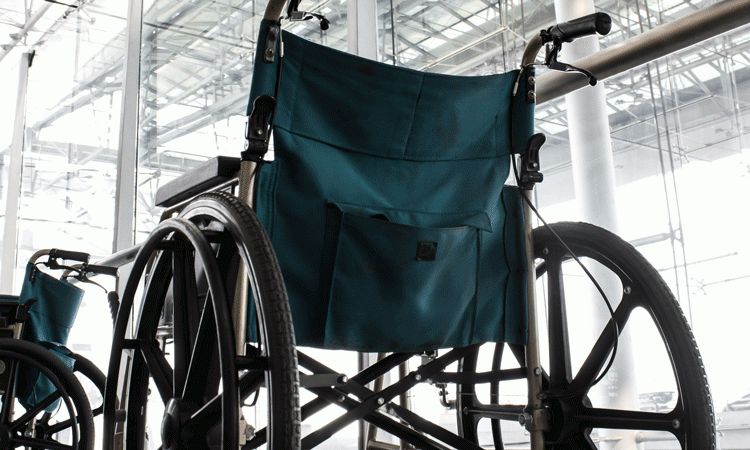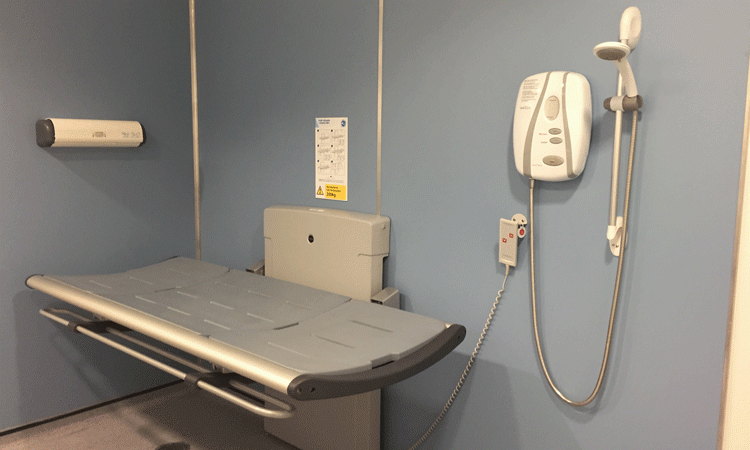Innovative solutions to facilitate accessibility within airports
- Like
- Digg
- Del
- Tumblr
- VKontakte
- Buffer
- Love This
- Odnoklassniki
- Meneame
- Blogger
- Amazon
- Yahoo Mail
- Gmail
- AOL
- Newsvine
- HackerNews
- Evernote
- MySpace
- Mail.ru
- Viadeo
- Line
- Comments
- Yummly
- SMS
- Viber
- Telegram
- Subscribe
- Skype
- Facebook Messenger
- Kakao
- LiveJournal
- Yammer
- Edgar
- Fintel
- Mix
- Instapaper
- Copy Link
Posted: 15 October 2019 | Laurel van Horn - Open Doors Organization | 1 comment
Laurel van Horn, VP Director of Programmes at Open Doors Organization, summarises fi ndings from a three-year project sponsored by Airport Cooperative Research Programme (ACRP), with examples from numerous airports.


In both the United States and Europe, the growth in demand for accessibility services is now outpacing the overall rise in passenger numbers. At large American airports, wheelchair assists already top one million per year, fuelled largely by the aging population. Meanwhile, “failure to provide service” makes up half of the disability-related complaints to airlines reported annually to the U.S. Department of Transportation, which doubled from 2005 to 2015.
At stake are not just levels of service (LOS) for air travellers with reduced mobility but also airport and airline operations since long waiting times for assistance result in delayed flights. How can the industry improve the travel experience for these customers now while preparing to meet even greater demand in the decades ahead?
In seeking answers to this question, Open Doors Organization and its collaborators – Alliiance, Arora Engineers, Trillion Aviation and Indiana University – undertook research that included a comprehensive literature review, focus groups, online surveys, participation at key aviation conferences and a dozen site visits to the most innovative airports. Aside from wayfinding, the research team considered all types of best practices and innovations with the goal of providing a comprehensive resource for airport directors and managers and other aviation stakeholders.
Here are some key recommendations with examples of how individual airports are putting these solutions into practice.


London Gatwick’s sensory room
Improve collaboration and communication
Whether it is the airlines who manage assistance for passengers with reduced mobility or the airport, communication and collaboration among all stakeholders are key to eliminating service gaps.
One solution is Ozion PRM Manager Software that is shared by airports, airlines and service companies, enabling each to have their own dashboard. Service companies can follow the passenger journey and adjust service timing accordingly, while airports and airlines can see if service level agreements are being met. At present, most airports worldwide get few if any statistics on how many travellers use their facilities, let alone how well they are being served. Little surprise, then, that their needs are overlooked or underestimated in development planning.
Involve the community
A growing number of airports now have disability advisory committees that include members with a variety of disabilities, most of whom represent local chapters of national organisations. Some airports like Atlanta, Miami and Los Angeles hold meetings monthly, while others like Minneapolis-St. Paul and Heathrow meet quarterly. These committees give airport planners, architects and designers a group to regularly consult on questions of regulatory compliance and inclusive design. They can also provide first-hand experience on inefficiencies in the airport, participate in audits and mystery shopping, contribute to disability awareness trainings, help with community outreach and join in emergency exercises.


London Heathrow’s changing space
Enhance independence and self-reliance
A guiding principle of the IATA Airport Development Reference Manual (10th ed., 2016) is that people with disabilities should be enabled to be as self-reliant as possible. This is echoed as well in ACI’s Airports and Persons with Disabilities Handbook (fifth ed., 2018). Solutions can be as simple as allowing customers to borrow wheelchairs so that a companion can assist; providing small duty-free style carts for carry-on items that can double as walking aids; and placing seats at regular intervals and wherever there is a queue. To address long distances, MSP and Montreal have set up electric cart transit systems by installing a set of well-signed benches at regular intervals. At Birmingham, travellers can borrow an electric scooter to get to their gate and shop or dine en route.
There are also high-tech solutions. Aira, a service in which remote agents direct passengers via video from their smartphone or smart glasses, is revolutionising travel for individuals with vision loss. More than 40 airports, mostly in the U.S. but also London Gatwick and Heathrow, now provide Aira at no charge to travellers while onsite. Whill, a self-driving wheelchair that addresses both wayfinding and mobility needs, should be available at Tokyo Haneda in time for the 2020 Olympics.
Embrace universal design and exceed regulatory minimums
International aviation organisations like IATA, ACI and ICAO have recently become advocates for universal design (UD). Both the Canadian Transportation Agency and Federal Aviation Administration also recommend use of UD principles. At Vancouver and Gatwick wide ramps between fl oors enable rapid movement of multiple passengers by electric cart while also minimising delays at elevators and enabling rapid emergency evacuation. At Minneapolis-St. Paul, universally-designed restroom stalls feature doors that swing out, side grab rails, space for a carry-on suitcase and a shelf.
By hiring architects skilled in UD that addresses a much broader range of needs than government accessibility standards, airports are making their facilities more user-friendly for travellers with cognitive and sensory disabilities. UD also pays much more attention to lighting and glare which particularly impact older travellers.


Vancouver’s wide pedestrian ramps
Mind the gaps and address unmet needs
In large complex environments with multiple stakeholders, it is inevitable that gaps in service will exist. One major gap in the U.S. and Canada is the ‘no-man’s land’ passengers face on arrival from ground transportation. Unlike Europe where airports designate arrival points and provide a kiosk to request assistance, travellers elsewhere can typically get help only at check-in. Seattle and San Francisco now hire contractors to assist to/from parking, light rail and the rental car centre. At Tokyo Haneda International Terminal, there is a clear division of responsibility: The airport handles assistance landside up to check-in while airlines cover the rest.
Airports are also beginning to address unmet needs through installation of new types of amenities: Adult changing tables; sensory and quiet rooms; service animal relief areas; and stoma-friendly restrooms. An ACRP report on the design of such amenities is due out in 2020.
Differentiate the accessibility service
Until quite recently, the only type of help for travellers with disabilities mentioned on airport and airline websites was wheelchair assistance. Research by the UK Civil Aviation Authority, not surprisingly, found that many individuals with cognitive or psychological disabilities thought there was no help available to them. The resulting CAA guidance on hidden disabilities has led to a variety of solutions including colourful lanyards for self-identification now being adopted in other countries as well. Service companies often take the blame when their staff show up with a wheelchair for someone who only needs an escort, but many contractors in the U.S. do not receive SSR codes from the airlines they serve. This is something that PRM software can easily fix through real-time data feeds.
Provide disability awareness training
Soft skills are as important as technology or infrastructure in creating a positive customer experience. This is especially true for older travellers and individuals with disabilities who need both information and reassurance. One airport that puts great emphasis on awareness training is SFO where basic awareness training is part of the badging process followed by an eight-hour class for all frontline employees. Ramp crew, too, need awareness of the importance of mobility devices to their users as well as hands-on training on how to safely handle all types of manual and power wheelchairs and scooters.
Educate customers on accessibility
The ACRP 210 Report devotes an entire chapter to pre-trip planning as this is so critical for these travellers. Airports and airlines should adopt the most advanced WCAG guidelines as these further enhance functionality while meeting earlier mandated standards. Including an International Symbol of Accessibility on the home page header, as at ATL and Phoenix, and organising information by disability type, as at Los Angeles and Seattle, makes content easy to find. A growing number of airports now include very detailed information including social stories and videos in formats that meet all needs. One great example is Heathrow’s special assistance video with audio description, closed captions and international sign language. Live chats especially benefit people with hearing or speech disabilities.
Don’t overlook disabilities when adopting technologies
While biometric screening with its promise of shorter lines and fewer documents to handle would make travel easier for most individuals with disabilities, their needs are often not being considered during installation. Manufacturers like Vision-Box design their facial recognition cameras to adjust in height and can also provide wheelchair accessible e-gates. There’s no reason to make these travellers join a queue at immigration checkpoints, as is now happening at major European airports, while everyone else breezes through.
Make inclusion central to your culture
The role of senior management is key to moving beyond a mindset which sees accessibility as benefiting only a few, and therefore not worth significant investment of scarce resources, to realising that it improves the experience for all customers and is a fundamental part of economic and social sustainability. Airports recognised as leaders in accessibility like Cincinnati-Northern Kentucky and Vancouver have CEOs who publicly advocate for corporate social responsibility and inclusion. By creating internal and external accessibility committees; making accessibility a mandatory part of all design, construction, contracts and purchasing; requiring awareness training across the organisation; and making hiring of people with disabilities a priority, these senior managers can ensure that inclusion will be institutionalised and lasting even after they move on.
The ACRP 210 Report will be published in early 2020. As airports expand and develop, passengers with reduced mobility must be continually considered if the aviation industry is to remain sustainable and successful.
Biography
Laurel van Horn has specialised in accessible travel, transportation and hospitality since 1987. For the past 15 years she has been the VP Director of Programmes for Open Doors Organization, the Chicago-based non-profit. Much of Horn’s work is in the field of aviation including development and delivery of training programmes and symposia for airlines, airline service companies and airports
Issue
Related topics
Airport development, Passenger experience and seamless travel, Passengers with reduced mobility (PRMs), Terminal operations



















Great article which will be very useful in my Travel Peer Support sessions at the NSIC Stoke Mandeville – looking forward to reading the report